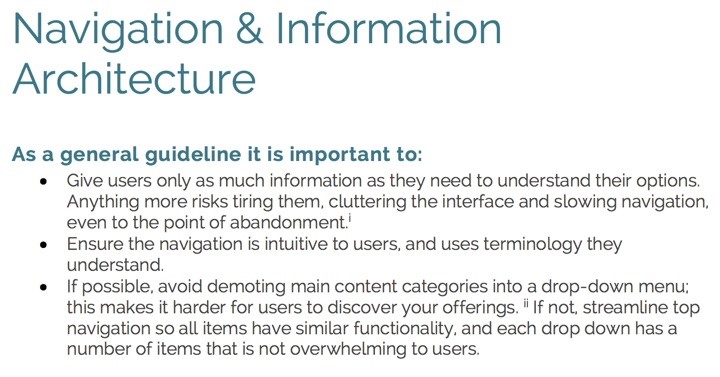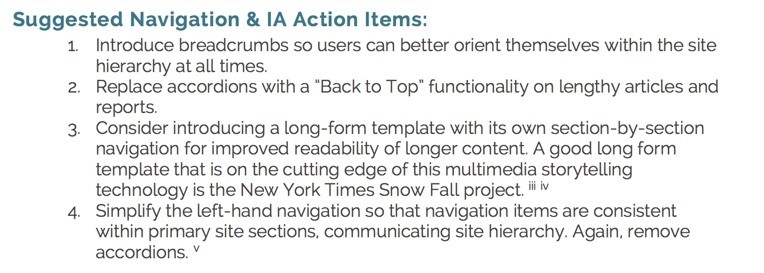Why a UX & Design Audit is a Great Way to Start Your Next Redesign

If you work for an organization that publishes ample digital content, chances are you’ve dreamt of redesigning your website to better promote this content. There are many other reasons (evolving SEO standards, web technology changes, browser updates, design trends, changes to company branding, etc.) that companies embark on a redesign journey, accompanied by abounding research in the web sphere about how often these should be undertaken. However, information on how to execute a redesign and recognize specific areas to focus on during one is less commonly available. After successfully completing a number of redesigns and working through different approaches, the Velir design team has identified a great way to begin the redesign process and pinpoint problem areas that need to be prioritized.
Kicking Off with a UX & Design Audit
At some point, many of us might have looked at a website and said, “I don’t really like how that looks” or “I don’t like what happens when I click here.” That’s because design and user experience can sometimes step into that confusing area of subjectivity. An area where we have reactions we cannot justify and find ourselves thinking; “I don’t exactly know why, but I don’t like it.”
This is likely because the web is still a relatively new domain and it blurs the border of what’s natural and instinctive. So when you have that gut instinct of not liking something on the web, yet not truly understanding why, chances are it’s not intuitive. As user experience (UX) designers, it is our job to delve into the human psyche and determine what is perceived as intuitive, so that you don’t have an unpleasant experience using an interface that deters you from coming back.
Consequently, a large part of our job ends up being educational. We need to ensure our clients understand what a good user experience is and how UX design and visual design are essential to the success of their online presence. This is always a challenge we welcome and find that a great way to address it is to start off engagements with a UX and design audit.
UX & DEsign Audits
Known as a heuristic evaluation, a term coined by Jackob Nielsen in 1995, this audit analyzes a site through the lens of modern web design best practices and assesses its alignment with industry trends.
So, Why Do We Do This?
Website redesign projects often involve capturing complete business requirements upfront, within a limited timeframe. But website requirements, UX and design best practices, and the nature of the web itself all evolve over time. There are many reasons why an organization may find itself needing to expand the functionality of its site – perhaps they’ve introduced a new content type, they need to incorporate new branding guidelines, or integrate with a 3rd party system. Other times, there may be a new set of tools available within their content management system, or browsers may have updated to support new technology.
Essentially, organizations outgrow their websites and when they don’t have the correct tools to build out what they need, they improvise, creating workaround solutions. Such solutions often impact the site structure and carefully curated visual language, deviating from the original design. These are the organizations that would most benefit from starting their redesign with a UX and design audit.
A good user experience, coupled with functionally sound visual design, is of paramount importance in providing value for priority audiences and encouraging them to return to a website. A professional, modern looking design has the ability to build trust between the visitor and the organization, which encourages the visitor to take action. Good web design is essential for digital success because it speaks on behalf of the organization, subtly communicating its worth and professionalism to its audiences, and turning them into customers or advocates. Therefore, an additional purpose of the audit exercise is to acknowledge that UX and design are crucial, strategic components of the website redesign process. It allows for the identification and prioritization of visual and functional design issues right at the beginning of a redesign effort.
And, How Is It Done?
The methodology in which we approach the audit is as follows. Using Nielsen’s heuristics as a guide, we divide the document into these 7 topical areas:
- Navigation & Information Architecture
- Page Layout
- Visual Design
- Homepage, or frequently visited templates
- Search
- Forms & Data Entry
- Help, Feedback, & Error Tolerance
We start off each topic with web design best practices related to that specific subject area, making sure they are relevant to our client’s website (seen in screenshot below). We do our diligence to find supporting research to strengthen our claims, as well as offer the insights of thought leaders in our field. So if our clients would like to learn more, they have a list of references they can review that align with our recommendations.

After an overview of applicable general guidelines, we list issues we have identified that don’t adhere to these guidelines, calling out specific areas of the site via annotated screenshots (not included below for confidentiality purposes). This is followed by a list of suggested action items for that topic (seen below).

Final Recommendations
As can be seen, the benefit of starting redesign engagements with an audit is twofold. We get the chance to familiarize ourselves with the site and our clients have a document of problem areas with possible solutions to act as a roadmap for upcoming redesign efforts. The document helps us decide whether we should start from the ground up with a clean slate, or perform incremental design and functional changes. At times, we determine that the existing site adequately serves target audiences and no changes are required despite internal stakeholder concerns. Any recommendation here will depend on a number of factors including the underlying structure of the site, user needs, budget and timeline constraints, and the resources that are available.
The decisions made with this information, however, are a crucial determinant of the website’s future. The success of a website lies in its foundation and structural building blocks. Without doing an initial assessment of its groundwork, having a comprehensive outlook on how to further enhance it, will be near impossible.



